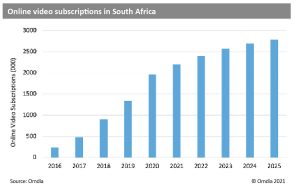
After more than 35 years of operation, TBI is closing its doors and our website will no longer be updated daily. Thank you for all of your support.
TBI Tech & Analysis: How Disney+ fits into South Africa’s SVOD boom

SVOD subs in South Africa (Click to expand)
South Africa’s SVOD landscape has seen rapid growth over recent years with global players joining regional operators in the country. Kane McKenna, research analyst at TBI sibling Omdia, explores how Disney+ might fare when it joins the competition.
After a tumultuous but ultimately fruitful early period for South Africa’s SVOD market, rapid sustained growth has been achieved for the past five years.
As in many markets, 2020 proved a boom year for SVOD with a 47% increase in active subscriptions. This growth has continued into 2021 and played a role in attracting services such as Disney to the country.
Barrier erosion & incumbent power
The past 18 months have eroded some of the traditional barriers to SVOD adoption in South Africa, namely the improved availability and affordability of mobile and broadband internet connections. Both increased in 2020 – mobile by 10% and broadband by 7%.
The combination of an expanded addressable market and the added marketing energy and content libraries of new entrants has the potential to accelerate the growth of SVOD subscriptions throughout the region in the coming years.
Existing market players such as MultiChoice’s Showmax and Netflix, which were the primary beneficiaries of the 2020 boom, currently dominate the SVOD landscape of South Africa with 750,000 and 859,000 subscribers, respectively.

Kizazi Moto
Both providers experienced excellent growth in 2020, with Showmax up 29% and Netflix up 55% on 2019 subscriber numbers.
Mouse House strategy
As such, Disney+ will be entering a territory where there are already several established players.
It has yet to reveal specific details of its strategy for South Africa, although its success in other countries, such as India, has been built on price (low cost) plus a strong mix of local and international content. Greenlights to date include animations Kizazi Moto: Generation Of Fire and musical comedy Kiff.
Disney has also favoured bundling its service with top OTT providers currently operating in the markets it wishes to enter. Such examples include Hotstar in India and Indonesia, and OSN in the Middle East and Northern Africa. In Indonesia, it also took account of the country’s low credit and debit card penetration by teaming up with local financial institutions to make it easier for subscribers to pay.
The move into South Africa forms only part of Disney’s upcoming regional expansion plans. A move into Eastern Europe has been delayed until summer 2022 to allow for a wider launch schedule at the same time, where Disney will launch not only into Eastern Europe and South Africa, but also select countries in the Middle East.
South Africa, however, represents an excellent location for these services to establish themselves before springboarding into other areas of the continent.
With combined pay-TV and online video revenue exceeding $2bn, the country is easily the most lucrative market in sub-Saharan Africa, being home to the pan-continental juggernaut MultiChoice, which controls DStv and Showmax.
Although Disney+ will face stiff competition from market incumbents, it will rely on its slate of highly regarded and well-known content to persuade the South African public to subscribe.
Kane McKenna is research analyst at TV & Online Video. The excerpt above is taken from his Omdia opinion article, Disney+ plans to follow BritBox by entering South Africa’s booming SVOD market.


